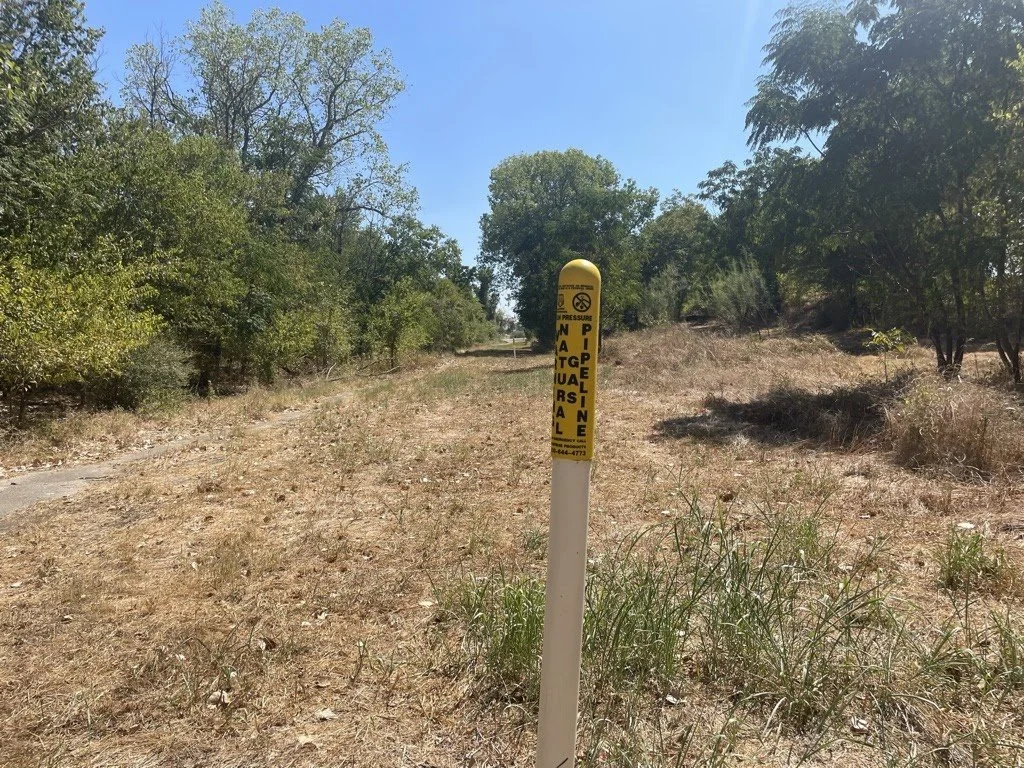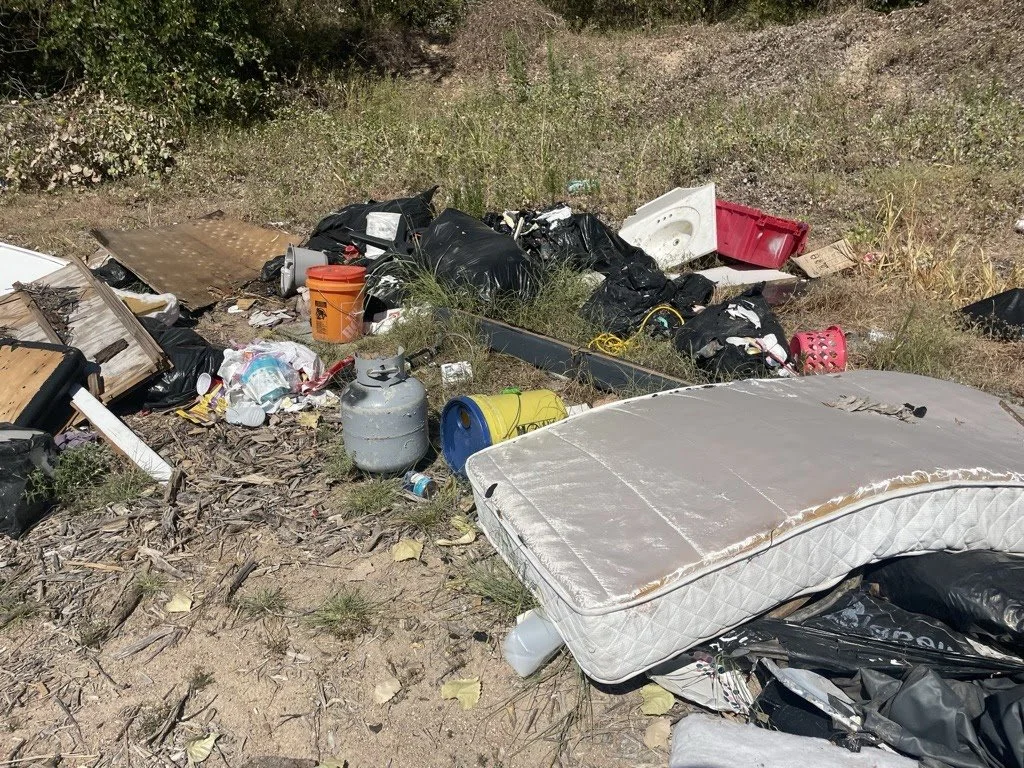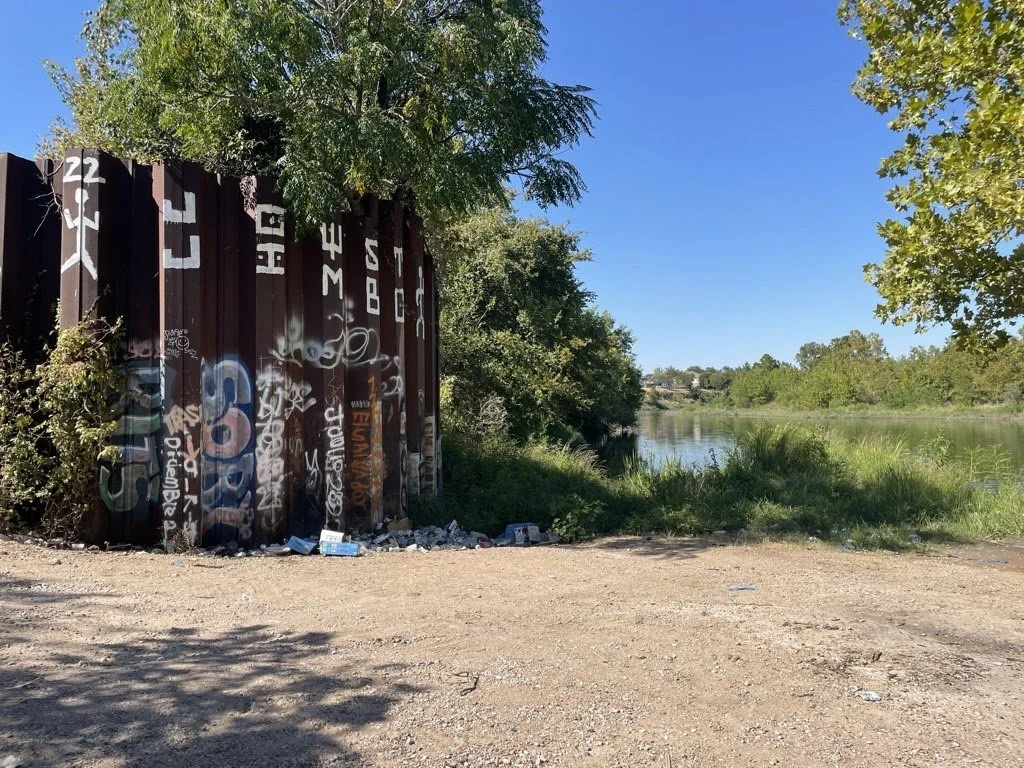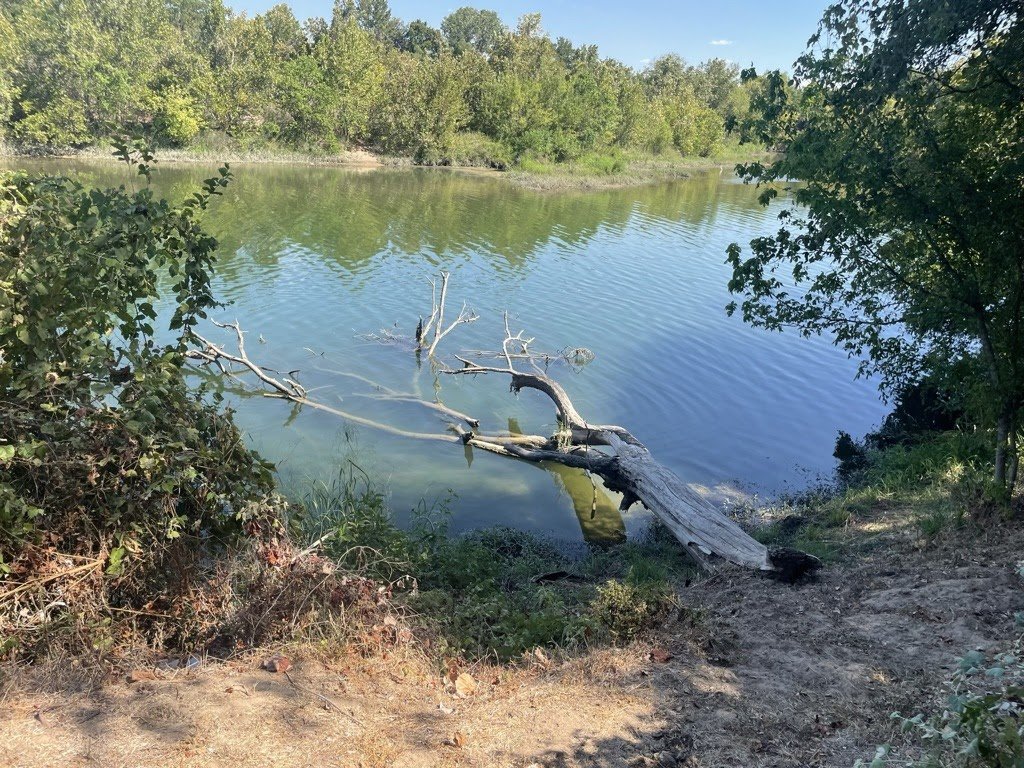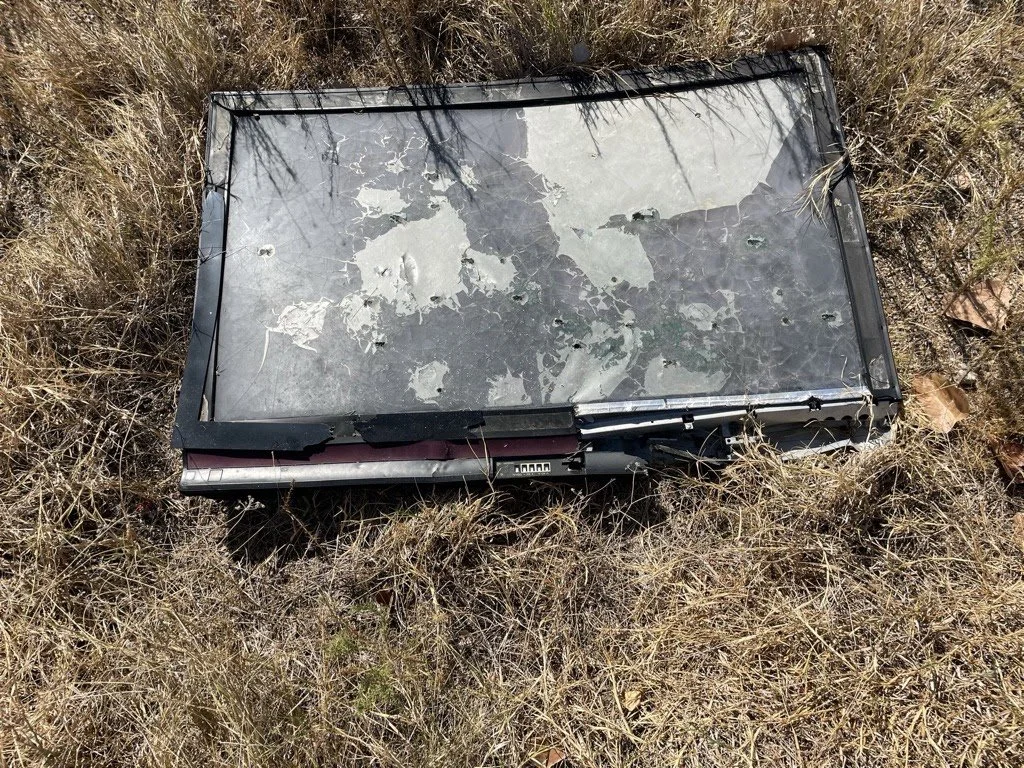There’s Something Truly Captivating About Bolm District Park
By Ryan Gossen
Summers like these are more than summers. They eclipse spring and fall, pushing the historical borders of seasons outward like the burning edge of a grassfire. The humidity brings no rain, shadows of trees hold no shelter, and denuded squirrels with tails like rats are passed out on branches, all four hands dangling over the sides. Cicadas throb and scream like entropy itself, and the blazing light and haze want to reach in and grab my brain through my eyes.
Being in harmony with nature is a standard by which I measure my health and happiness, but not like this. I want to be in harmony with another nature, something farther north, or long ago. I get a form of seasonal affective disorder. I go out for walks, but only after the sun has been down for a few hours. I start to hate light.
I knew where this was going: nihilism, depression, vampirism. I’m a father and husband. I can’t afford to become a vampire, so I looked for a reason to get out of the house in the middle of the day. I had this old bicycle frame in my garage, it was a good frame and it would have been a shame to throw it away, so it sat there for years, contributing to the chaos in my garage and in my mind. So I made the inconvenient trip across town to hand it over to the Yellow Bike Project, the bicycle equivalent of organ donation.
After dropping off the frame, it felt like I had traveled a great distance and should explore something, so I searched Google Maps for a nearby park. There was an unfamiliar green shaded area on the banks of the river. In two decades of living in Austin, I had never seen or heard of it. Bolm District Park appeared on my phone like a ghost park that does not exist in normal reality, only appearing to certain people under specific conditions, like Alice’s rabbit hole, or the train platform in Harry Potter.
This might’ve been my only chance to see it. It was too hot to be walking around, but I was past that. Besides, I would have the place to myself, like a park at 3:00 a.m., or in a thunderstorm, or after a nuclear apocalypse.
Google tossed me onto Ed Bluestein, a notorious four-lane frontage road where aggressive and desperate people accelerate and cut each other off to the best of their abilities. All four lanes aim at a steep hill, parallel to the walled-off particle accelerator of Highway 183. Four-cylinder 1990s sedans roll down their windows and shut off their A/C’s to summon more power. Just before the hill begins, a subtle break appears in the curb, an opening into broken asphalt and tall brush.
This is Smith Road. It’s unmarked but known to Google. Hoping that fluttering my brake lights and signaling my turn would be enough to prevent me from being rear-ended, I made the exit as fast as I dared and immediately slowed to a stop.
The only signs in Bolm District Park.
Trees, dry but alive, leaned in from both sides and brushed the roof as I entered the tunnel. I pushed past branches that intruded into the road. It felt like maybe a bad idea, like this was a good place to get car-jacked by barbarians. Homeless men have been making certain parts of Austin feel dangerous in recent years and I have mixed feelings about them. At another public park, I recently found an encampment with loose dogs and hand-drawn signs that said, without irony, “Private Property.”
There were no signs of any kind here, no one felt the need to claim this place. Only the map claimed it was something. The road continued a few hundred yards, made an abrupt 90-degree turn, and let out into a pristine grid of neat houses and wide streets. This was the Knollwood Neighborhood, a pocket suburb isolated from the rest of the world between 183 and the Colorado River. I parked here and walked back down Smith Road, looking left and right.
I felt less out of place on foot than in a car on this road. At the turn, a large swinging gate was locked shut, as if to block automobile traffic. Several medium-sized trees had grown up behind, reinforcing it. I followed a footpath around the gate and over an embankment, thinking I was done with roads, but under my sandals, I felt again the roll of pebbles on asphalt, cracked and covered with dirt and weeds. A sign stood in the middle of the weird space, one of a series of signs extending down the clearing, telling me I was standing over a gas pipeline. These are the only signs in Bolm District Park.
I followed the pipeline to a caliche road that passed stands of heat and drought-tolerant invasive trees. The road led to other roads the way social trails split and intersect in an over-visited park. It would have felt like a maze if I had been in a car and not experiencing it very slowly. I felt out of place for being on foot, a wet, soft mammal exposed on this hardpan. Homogeneous piles of construction rubble were at random intervals along the side of the road: uprooted concrete footings that held the texture of the ground they were set in, the tile and tub of a demolished bathroom, a giant hairball of rebar, rolled up under tension into an airy, dangerous sculpture.
A left turn opened out into a surface of dusty matzoh and coarse, bone-colored wood chips. It was hard to estimate the space, maybe ten acres of no life, level and hard. The dust made a perfect canvas for tracks. I saw no evidence of human feet, but many birds, canids, and pig hoofs with their little dew claws in the back. The presence of feral pigs changed the spirit of the place for me; a bright intelligence with its own agenda moving across this suburban-industrial space made me feel less alone.
Trash in Bolm District Park. These were life-piles.
A plastic toy boat bobbed on the dust out in the middle of the expanse, as if someone found it, played with it, then continued on. I've seen items carried by pigs in this way; bottles with tooth punctures carried into day beds in Arundo stands and left next to bones. A punctured magic marker, a mutilated two-liter Coke bottle, fetish items for a tribe of invasive apex mammals. I once found a series of hog skulls in a cave of cedar limbs. No other bones, just skulls, like memento moris of loved ones. Do pigs have a concept of death? Somewhere in a cedar thicket, a tusked Hamlet grunts a soliloquy.
I moved across the clearing to reach its most obvious features: two trash piles. These were life-piles, like housemates emptied out the bedroom of an adult. Old CDs, clothes, kitchen trash, desk drawer trash, and of course, a mattress. The mattress is the quintessential illicit trash item. Everyone owns a mattress and no one knows what they will do with it when they no longer want it. It’s so intimate it can transmit skin-borne parasites. This one, if I pressed my face into it, would probably not yield the smell of its former owner, having been blasted in the sun until the top is white and the bottom beige. Or maybe there would be the faintest smell. Even after the heavy rains that preceded this extinction event summer, maybe the head smell of a real person remains in traces. No doubt the hogs can smell it.
Graffitied walls. Shadows beyond doorless doorways. Jimbo.
Through a thin barrier of cottonwood saplings, I found myself on pavement again, before a small building with graffitied walls. Again I felt unsafe. There were shadows beyond the doorless doorways. The spray paint made it clear that someone, specifically Jimbo, felt they had sovereignty here. It was some kind of outbuilding for the gravel operation. There were shelves where tools might have lived, a table outside, massive concrete pedestals dotting the slabs around, maybe footings for a massive rock-crushing tower.
I was lightheaded, I stepped under the eves of this building and sipped my electrolyte water. My phone, which I carried in my hand, had shut itself off, and when I tried to turn it on, it just showed an image of a thermometer and an exclamation point.
Why would anyone be here? No one was here but me. No pigs, no lizards, no birds, no gang bangers, and no Bolms.
Before it was beaten into hardpan, this was the Bolm farm. Some people are farmers in their blood, but A.D. Bolm was a money guy. Buying a farm is a classic rich guy move in Texas. You can claim agriculture tax exemptions and set it up as a business while your land appreciates in value. When the farm loses money (as it surely did in the 1930s), you can write that off, along with the purchase loan, against income from your other more profitable business: the largest laundry business in town. Newspapers referred to him as “Laundryman A.D. Bolm,” in the way that Daniel Plainview refers to himself as an “Oilman” in There Will Be Blood.
By the 1930s, A.D. and Mae Bolm were an established Austin power couple with investments around town and a nice new house near the university where their daughters attended. A.D.'s record as a rancher and a Laundryman can be found in a series of write-ups in the Austin American Statesman, which can only be described as advertorials. This piece on Bolm’s use of a fleet of Overland Willys for the delivery of laundry manages to flog both his laundry service and the car. Another paints a flattering picture of the Bolm farm operation and its use of Farmall Tractors.
There is no label or container indicating an advertisement. I find it reassuring to read hand-crafted bullshit, written by a real human for a purpose I can understand. Nestled in the sleazy copy are interesting details. A.D. reported making a 2900-mile drive to St. Louis and back in one of his Overlanders. I’m sure it was a fine machine for the time, but that trip must have been no joke. Maybe he went back to pick up his father, who came to live with the family in their new custom house near Peace Park.
The farm was outside of town, to the southeast, on the alluvial floodplain around the Colorado below Longhorn Dam. There wasn't much else out here, and the road that serviced it was and still is named Bolm Road. The east side is known for deep, dark topsoil, and it must have been some decent farming.
In 1972, the land was sold to Capital Aggregates—one of the many gravel operations in Austin who scraped and dredged the river basin—and used, unglamorously, as a place to put piles of gravel. Bolm District Park has been scraped and packed so thoroughly, it can be hard to spot the transition from caliche to pavement.
Have you ever taken a stroll through Bolm District Park and wondered what makes it so special? This Austin, Texas, park is known for its lush greenery, wide open spaces, and unique history. From the local legends to the vibrant wildlife that call this place home, there’s something truly captivating about Bolm District Park.
After I visited, I found this article about Bolm District Park on the business website for Austin Roofing and Water Damage. It’s an orphaned page, you can’t find it from the site navigation. It’s the longest, most detailed piece of writing on this park I found anywhere.
There are also playgrounds with slides, swing sets, and sandboxes; picnic tables where families can enjoy lunch together; basketball courts; sports fields; volleyball courts; disc golf courses – you name it!
The Colorado looked green and thick and still…
This goes on for over a thousand words, culminating in the promise of a Nature Center with live animals, and the assertion that no one has an excuse not to visit. I enjoyed imagining an energetic “content creator”, perhaps the source of one of these trash piles, toiling away in a studio apartment. Asked to write a few words about something relevant to roof repair, they were unable to stop themselves from describing an elaborate, fictitious city park. I admire that kind of inspiration. A year ago, there would be no better explanation, but in 2023, it’s much more plausible that someone told ChatGPT to write an article about a park in Austin and dropped it into their website to improve SEO. Even online, this place is used ruthlessly.
I cut into the brush, over an embankment, and finally reached the river. The Colorado looked green and thick and still, but I walked into it in my sandals. It was cooler than my body temperature, and I didn't mind the scum that collected on my shins as I trudged upstream. I reached a flat promontory where it looked like someone came to fish often. I knew this place. There was a red wall of corrugated iron, like a coffer dam that faced the river, likely a place from which cables had spanned to move something across. I had seen this wall from a kayak when I paddled downstream from Longhorn Dam. From the river, it is a bizarre outcropping, the iron graffitied wall, the little mesa, and a wheeled, swiveling office chair.
A coherent road went up around the coffer, back towards the cleared caliche uplands. An immense clearing extended left, out of the official park, according to the map, but there was no sign facing either direction. There was some kind of tower down there, a rock crusher. The Knollwood Neighborhood where I had parked is up in arms because that tower produces enough airborne silica to make your eyes burn when the wind shifts. Silica gives people lung cancer, but gravel operations have been the thing to do here for a long time. When I fly up to Denver, I’m always surprised to look down and see the huge ponds in the curve of the Colorado River where they've been pulling out gravel for the past hundred years. One of these ponds, just across the river but invisible behind a tree-covered berm, is bigger than Bolm District Park itself. The ponds seem forbidden and abandoned, a privately owned floodplain, utterly unloved, and made bizarre by these unlikely, isolated bodies of water, filled with fish whose eggs travel on the legs of birds.
A flat-screen TV with a spread of 9mm holes across its surface.
In the 1950s, before Longhorn Dam went in, these gravel operations went up the river right into downtown, but this seems to be the closest one now. It would be a perfect place for a car-full of teenagers to careen around and drink by the river. But they would have to be bold, because it also feels like a perfect place to come with your gang rival duct taped in the trunk of the car to make them dig their own grave in the headlights.
I passed more singleton trash piles on the way back, random appliances, small personal piles, a flat-screen TV with a spread of 9mm holes across its surface. Bolm District Park continued to deliver these rapid non-sequiturs, the edges of partial stories and interrupted intentions. I realized no funded public park, supervised and assigned to interpretive and law enforcement rangers could come close to this. A carefully designed public park would delete all these stories and select one, maybe the nearby Chisholm Cattle Trail.
Maybe, since the place is called Bolm District Park, we are obliged to tell the story of Laundryman A.D. Bolm and his slow, yet plausible rise from St. Louis Shoe Salesman to Austin Businessman and tax-savvy farmer. A bronze plaque will be cast listing the funding sources plus the names of the government employees who were in the room when they approved the plan.
But I’d rather know how this office chair came to be in this murder turn-around. Or about Jimbo, who tagged up the concrete footings by the abandoned outbuilding. Or even a thousand words from Chat GPT that make me question the nature of truth. Anything but another plaque about a meeting.
This place is sad, but it’s sad the way a good song can be sad. It’s secondary wilderness, it’s a ruin. It’s alive and speaks with a voice I can hear. I would be sad to see it turned into sports fields, but maybe that’s its best use now. Kids should be unafraid to play here. There’s no need to preserve ruins like this, they are everywhere. Ghosts, graffiti, and feral hogs do not need our curation.
A school bus was letting kids off in Knollwood and parents eyed me as I walked up from the road no one used. I don’t think I looked homeless but it’s hard to tell with this heat. Everyone wears shorts and a tee shirt. I started the car and drank the last of my water and the A/C blasted my face with hot air. When I made the U-turn at the top of the hill, the machine breeze was finally cool and I felt sweat evaporate from my head.
Ryan Gossen is a writer living in Austin, Texas, where he also pursues dance, Brazilian Jiu-Jitsu, and climbing, and is an active member of Texas Search and Rescue. He has had many vocations, including user experience (UX) designer, experimental psychologist, construction worker, arborist, and ski bum. He writes mostly about man’s interaction with nature. More of his writing can be found on his website.
